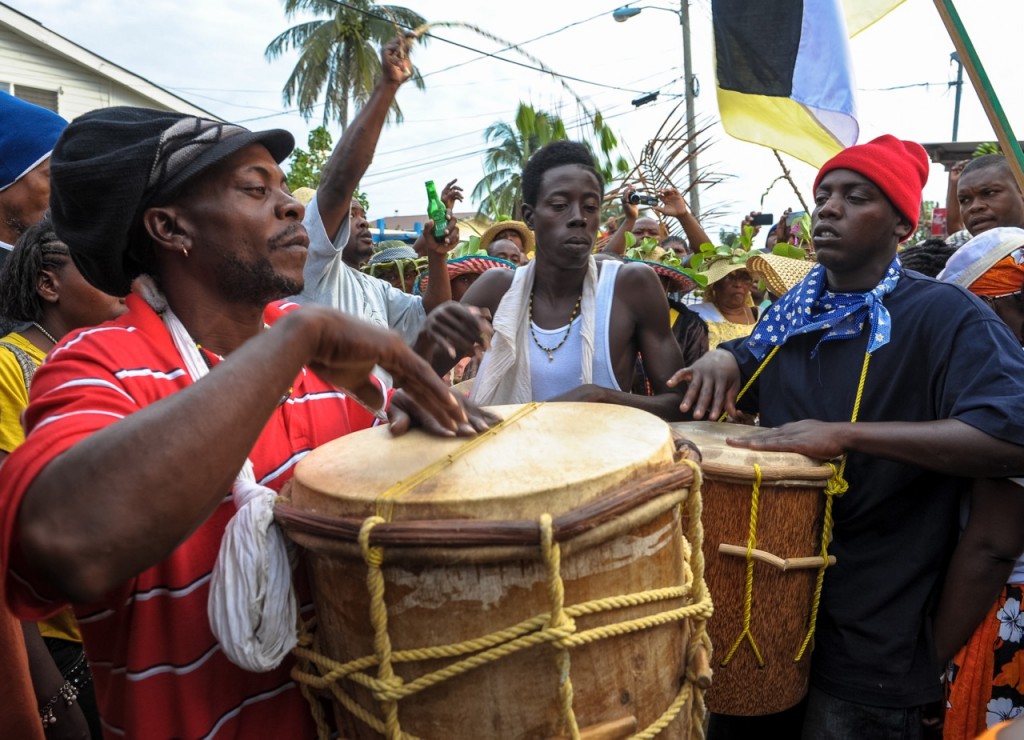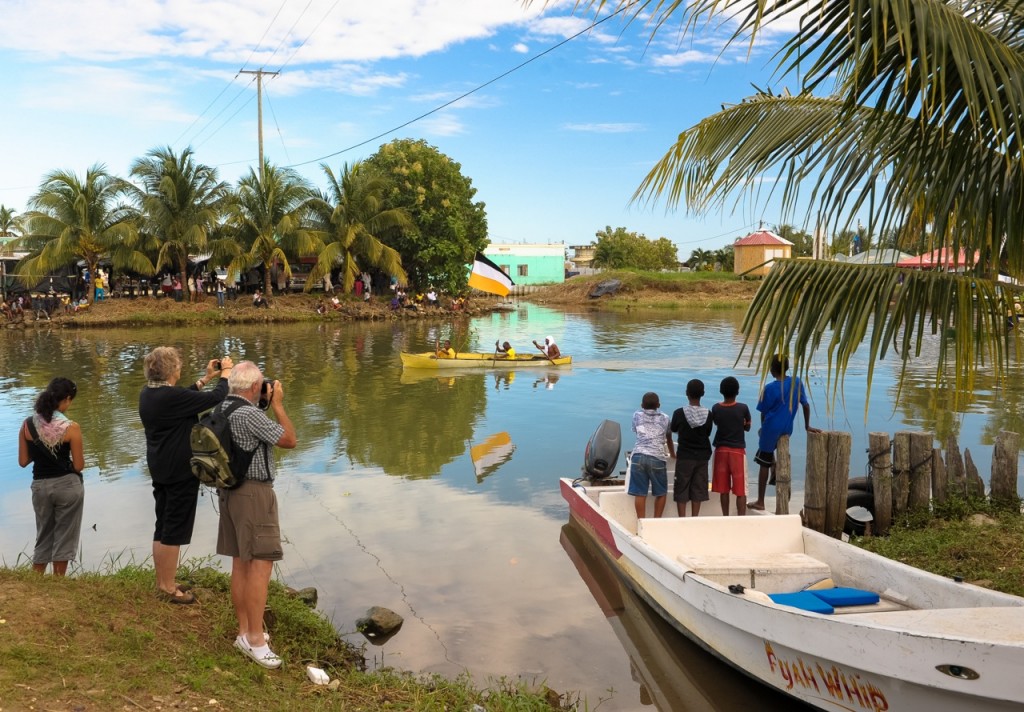
Drummers celebrate Settlement Day in Dangriga. Photo © Lebawit Lily Girma.
Garífuna Settlement Day, one of Belize’s biggest cultural celebrations and an official holiday, takes place on November 19th. Every year, the country commemorates the arrival of the first Garinagu people—an Amerindian people who are descendants of West Africans and Caribs—to Belizean shores on November 19, 1802.
“You can’t come to Dangriga on Settlement Day and not dance under the shed, Lily. You have to try it!”
By midnight, crowds have spilled into the streets of this sleepy Afro-Caribbean town on Belize’s east coast. Dangriga has turned into one large, outdoor pedestrian party.I gaze at the circle of revelers, a stone’s throw away from the sidewalk where my friends and I are standing. They’re shaking their hips in a partially obscured space under a thatch roof, chanting in unison. Their voices manage to rise above the reverberating beat of drums. Just a few feet away from the dancing, a group of men are slamming dominoes and throwing back white rum in the dark of night. By midnight, crowds have spilled into the streets of this sleepy Afro-Caribbean town on Belize’s east coast. Dangriga has turned into one large, outdoor pedestrian party.I glance at my backpack, sitting at my feet, protecting my precious camera gear. But those thoughts are interrupted. “We’ll look after your bag; it will be fine. Come on, let’s go!”
My Belizean friends are right. There is no coming to Dangriga, the hub of Belize’s Garífuna culture, on the eve of their most significant annual celebration and not dancing to the beat of their ancestral drums. As a writer, watching the festivities from a close distance isn’t good enough. How would I know what it felt like if I didn’t take the plunge myself?
I leave my belongings in safe hands and timidly approach the intimate, congested circle. In seconds, I find myself propelled into the wave of bodies, gyrating hips, and raised hands. I’m not sure what is being chanted and hurled, or even how to really move my hips their way, but the drums carry me into my own rhythm, my face shining under the single fluorescent light bulb. In the occasional break in the crowd, I glimpse the line of drummers at the front, beating their instruments and chanting to keep the crowd going.
After the drumming and dancing under the shed, the street outdoor party continues until dawn. Alongside residents, I line up down the banks and bridge of the North Stann Creek River, a cup of hot cassava porridge in hand, awaiting the arrival of the dugout canoes carrying reenacting Garinagu arriving in Belize.

Canoes arrive to reenact Garinagu arriving in Belize. Photo © Lebawit Lily Girma.
The commotion and festivities begin as soon as the canoes appear in the sea, Garífuna flags—black, white, and yellow—swaying in the wind and cassava leaves spilling out of the boats.
Once they reach the shore and are emptied, the chanting and drumming that take place are unlike any I have experienced in the region. A sea of women and men in traditional outfits chant and march through town, all the way to the Sacred Heart Church for a traditional mass. The afternoon hosts a lively, carnival-like street parade, with dancers and trucks blasting punta music. By this point, I’ve been up for 24 hours, yet I feel exhilarated and alive.
While celebrations take place in each of Belize’s Garífuna towns and villages—including Punta Gorda, Hopkins, Barranco, and Seine Bight—the largest of all, complete with a live reenactment of the arrival of the first settlers in dugout canoes, takes place in Dangriga.
The hub of Garífuna life and Belize’s cultural capital, Dangriga has earned the reputation of being one of the least touristy parts of Belize, but it’s also one of the most authentic. Independent travelers will find off-the-beaten-path experiences here—from visiting the Sabal cassava bread-making farm to watching local fishermen at work at sunrise, surrounded by pelicans.
The city is unpretentious and raw, so don’t skip “Griga” thinking it’s just a pit stop. It’s well worth an overnight stay, and it’s close to some of Belize’s most beautiful offshore cayes, including South Water and Tobacco. Accommodations are few in the city itself, but they offer a decent range from hostel rooms to double bed guesthouses and the seafront Pelican Beach—the only full resort in town.
Arrive in “Griga” on the afternoon of the 18th—via a Tropic Air flight or by chicken bus—and settle in your hotel before heading out near sunset to watch the town turn into one big outdoor party with street parades, live concerts on stages set up around town, and traditional dances. Vendors sell snacks and hot Garífuna foods, ensuring you don’t down any Belikins on an empty stomach.
If you’re up for a full day of immersion into one of the world’s most unique and colorful cultures, plan ahead for Settlement Day weekend in Dangriga, Belize—and make sure you dance under the shed.